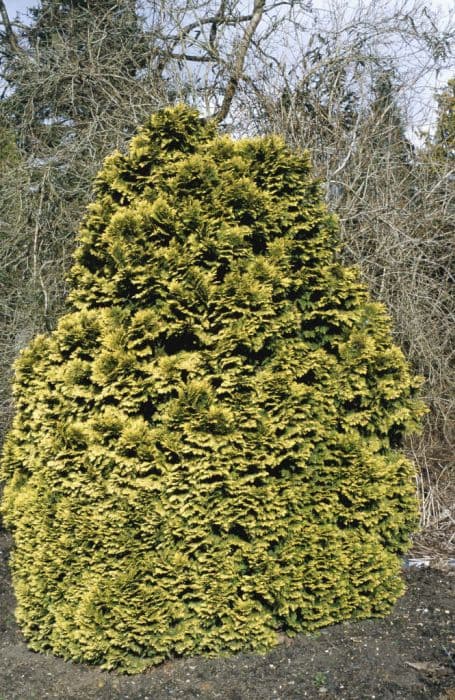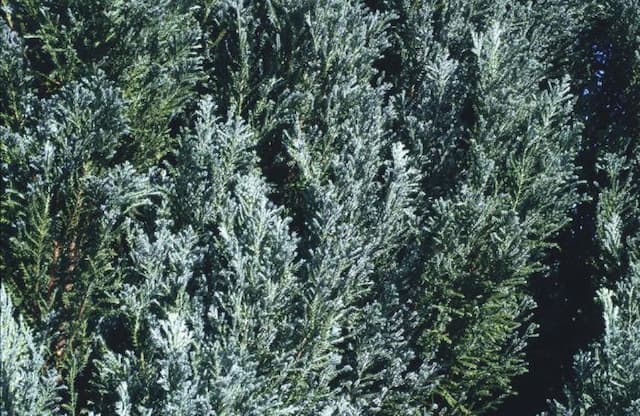Old Gold Juniper Juniperus × pfitzeriana 'Old Gold'

ABOUT
'Old Gold' Juniper is a vibrant, evergreen shrub renowned for its striking foliage. This plant features a mix of golden-yellow and green foliage, with the golden tones being more prominent at the tips of the new growth, creating a glowing effect. As the seasons change, the gold color intensifies, adding visual warmth to the landscape. The leaves are needle-like and tightly packed, giving the plant a dense, fine-textured appearance. The 'Old Gold' Juniper assumes a naturally mounded, spreading shape that gently drapes over the landscape. This gracefully spreading form makes it an excellent choice for an eye-catching ground cover or for adding splashes of color to rock gardens. Its foliage tends to become slightly more muted in winter, yet it retains its color well, staying attractive throughout the year. This shrub is easy to identify due to its unique color and is often chosen for its low maintenance needs and the bright accent it provides.
About this plant
 Names
NamesSynonyms
Old Gold Juniper, Pfitzer Juniper.
Common names
Juniperus × pfitzeriana 'Old Gold'.
 Toxicity
ToxicityTo humans
The Pfitzer juniper, as Juniperus × pfitzeriana 'Old Gold' is commonly known, is not considered highly toxic to humans. However, consuming parts of this plant, particularly the berries, can cause gastrointestinal irritation, resulting in stomach pain, vomiting, or diarrhea. Continuous ingestion over time can lead to more severe health issues.
To pets
The Pfitzer juniper is generally regarded as having a low level of toxicity to pets. Ingesting the plant can lead to mild gastrointestinal upset in animals, such as vomiting or diarrhea, but it is unlikely to cause severe poisoning or long-term health consequences. However, as with any non-food plant, it is best to prevent pets from consuming it to avoid any potential discomfort.
 Characteristics
CharacteristicsLife cycle
Perennials
Foliage type
Evergreen
Color of leaves
Gold
Height
4 feet (1.2 meters)
Spread
6 feet (1.8 meters)
Plant type
Shrub
Hardiness zones
4
Native area
Cultivar
Benefits
 General Benefits
General Benefits- Drought Tolerance: Once established, Old Gold Juniper is highly tolerant of drought conditions, making it ideal for regions with low rainfall.
- Low Maintenance: It requires minimal care, which is perfect for those who prefer a low maintenance landscape.
- Erosion Control: Its dense, fibrous root system helps to stabilize soil and prevent erosion, particularly on slopes.
- Year-Round Interest: With its golden to bronze foliage, Old Gold Juniper offers year-round color and visual interest in the garden.
- Wildlife Habitat: Provides shelter and nesting sites for birds, while the berries can be a food source for wildlife.
- Adaptive Growth: It adapts well to a variety of soil types, though it prefers well-drained soils.
- Design Versatility: Suitable for use in hedges, foundation plantings, or even as a specimen plant.
- Deer Resistance: Generally resistant to deer, which can be an advantage in areas where deer browsing is a problem.
- Compact Size: It is a relatively compact conifer, making it suitable for smaller gardens where space is limited.
 Medical Properties
Medical PropertiesThis plant is not used for medical purposes.
 Air-purifying Qualities
Air-purifying QualitiesThis plant is not specifically known for air purifying qualities.
 Other Uses
Other Uses- Juniper wood is naturally rot-resistant and can be used for making outdoor garden structures such as arbors, trellises, or fencing, providing both function and aesthetic appeal.
- The dense foliage of 'Old Gold' Juniper can be sheared into artistic topiary shapes, which can be used as focal points in gardens or as living sculptures.
- Dried foliage and berries of the Juniper can be used as a natural dye for textiles, offering shades of green, brown, or yellow depending on the mordant used.
- The aromatic wood chips and branches of Juniper can be used for smoking meats and fish, imparting a distinct flavor that is appreciated in culinary practices.
- Juniper branches can serve as a natural pest repellent when placed in wardrobes or drawers, helping to protect clothes from moths and other insects.
- Woodworkers may utilize 'Old Gold' Juniper wood to craft small items like boxes, bowls, or decorative objects, valuing its aromatic quality and color.
- The evergreen foliage of this Juniper can be used in seasonal wreath-making and garlands during the winter holidays, providing a splash of color and texture.
- Oil extracted from the foliage and wood of Juniper can be used as a natural wood polish or conditioner, enhancing the appearance of wooden furniture.
- In landscape design, 'Old Gold' Juniper can be used to stabilize slopes and control erosion thanks to its extensive root system.
- Juniper branches can be used in floral arrangements as a long-lasting greenery option, adding both structure and a pleasant aroma to the composition.
Interesting Facts
 Feng Shui
Feng ShuiPfitzer Juniper is not used in Feng Shui practice.
 Zodiac Sign Compitability
Zodiac Sign CompitabilityPfitzer Juniper is not used in astrology practice.
 Plant Symbolism
Plant Symbolism- Protection: The juniper plant has been traditionally associated with protection. Its wood was often used to ward off evil spirits in various cultures.
- Purity: Juniper is commonly believed to purify and cleanse. In some traditions, the berries and branches are used to create smudge sticks for purification rituals.
- Healing: The antiseptic properties of juniper make it symbolize healing. It has been used in herbal medicine to treat a variety of ailments.
- Endurance: Junipers are hardy plants that can thrive in harsh conditions, symbolizing endurance and the ability to withstand difficulties.
- Sanctuary: Providing shelter and sanctuary for wildlife, especially birds, juniper plants are seen as symbols of a safe haven and support for those in need.
 Water
WaterOld Gold Juniper should be watered regularly, especially during its first growing season to establish a deep, extensive root system. Once established, the watering frequency can be reduced. It’s best to water deeply rather than frequently, providing the plant with about 1 to 2 inches of water per week, depending on the soil moisture and climate conditions. During hot, dry spells, you might need to water every 5 to 7 days, while in cooler, moist conditions, watering every 10 to 14 days may suffice. Use a hose or drip system to allow water to penetrate deeply into the soil, reaching the roots without wetting the foliage.
 Light
LightOld Gold Junipers thrive in full sun conditions, so it’s best to plant them in a spot where they receive at least 6 hours of direct sunlight each day. They can tolerate partial shade, but their coloring and growth are optimal when provided with full sun exposure. Avoid deeply shaded areas, as this can lead to leggy growth and a sparse habit.
 Temperature
TemperatureOld Gold Junipers are hardy and adapt well to a range of temperatures. They can tolerate temperatures as low as -20 degrees Fahrenheit and as high as 100 degrees Fahrenheit, although they prefer the cooler range for optimal growth. The ideal temperature range for Old Gold Junipers is between 60 to 80 degrees Fahrenheit, which promotes healthy development and maintains their vibrant coloration.
 Pruning
PruningPruning Old Gold Junipers is necessary to maintain their shape and promote healthy growth. It’s best to prune in the late winter or early spring before new growth starts. Prune sparingly, only removing dead or diseased branches and shaping lightly as needed. These junipers do not require heavy pruning; over-pruning can lead to bare spots and damage the plant's natural form. Annually check and prune is usually sufficient.
 Cleaning
CleaningNot needed
 Soil
SoilOld Gold Juniper requires well-draining soil with a pH range of 6.0 to 8.0. The best soil mix for this plant is a combination of loam, coarse sand, and peat, which provides good drainage while retaining sufficient moisture. To enhance drainage, incorporating gravel or perlite can also be beneficial.
 Repotting
RepottingOld Gold Junipers are typically grown outdoors and do not require frequent repotting. However, when grown in containers, they should be repotted every 3 to 4 years to prevent root-bound conditions and to refresh the soil.
 Humidity & Misting
Humidity & MistingOld Gold Junipers prefer a dry to moderate humidity environment. They are well adapted to outdoor conditions and do not require high humidity levels, making them suitable for regions with low humidity.
 Suitable locations
Suitable locationsIndoor
Old Gold Juniper not ideal for indoor growth; needs full sun.
Outdoor
Plant in full sun, well-draining soil, water deeply, infrequently.
Hardiness zone
4-9 USDA
 Life cycle
Life cycleThe life of a 'Old Gold' Juniper begins with seed germination, where seeds sourced from a mature plant develop in well-draining soil under the right conditions of light and moisture. Following germination, the seedling stage involves the growth of the young plant as it establishes roots and produces its first needles, requiring care to ensure enough light and water but also protection from extreme elements. As the plant enters the juvenile stage, it exhibits rapid growth, expanding both its root system and foliage canopy, which is characterized by its golden-yellow to bronze foliage color. In the mature stage, the 'Old Gold' Juniper achieves its full size and shape, which includes a broad, spreading habit and dense, decorative foliage that is particularly valuable for landscape purposes. During this stage, the plant may also produce cones, with male and female reproductive structures usually found on separate plants. Finally, in its senescence, the older 'Old Gold' Juniper’s growth slows, and it may become more susceptible to disease or environmental stress before eventually dying.
 Propogation
PropogationPropogation time
Spring-Early Summer
The Old Gold Juniper, botanical name Juniperus × pfitzeriana 'Old Gold', is most commonly propagated through semi-hardwood cuttings. This technique is usually carried out during the late summer, when the new growth has begun to mature and harden slightly but is not yet fully woody. Cuttings about 4 to 6 inches long are snipped from a healthy parent plant and the lower needles are stripped off to expose the nodes. The base of the cutting is then dipped into a rooting hormone to promote root development and planted in a well-draining soil mix. The environment should be kept humid, and the soil consistently moist, but not waterlogged, to encourage rooting without rotting the cuttings. Rooting can take several months, after which the new plants can be gradually acclimated to less humid conditions before being planted in their permanent locations.









